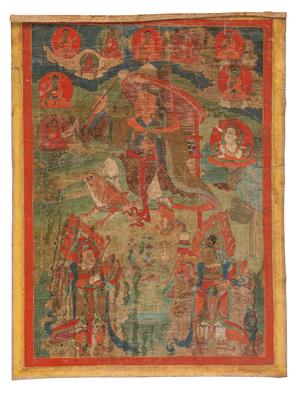A Thangka of Dharmata, Tibet, Early 18th Century

pigment and water-soluble binding agent on fabric, gold paint, image size 60 x 42 cm, rubbed, (Hr) We are grateful to Dipl. Ing. Uwe Niebuhr, BA MA for his assistance in cataloguing this work.
The present thangka shows Dharmatā, the servant of the 16 arhats of Tibetan Buddhism. Dharmatā is always depicted in connection with the group of the arhats and is not regarded as a monk, although he is often counted as the 17th arhat. He is a lay companion (Sanskrit upāsaka), who assists his group of monks by carrying their books, clothes and food on his back carrier. Dharmatā advances with big steps in the middle of the picture, accompanied by a ferocious tiger. He holds a golden fly whisk (Sanskrit cāmara) with his raised right hand, and a golden vase (Sanskrit kalaśa) in his left hand in front of his chest. Despite his peaceful facial features, two sharp fangs are visible in his slightly opened mouth. His dark hair is wrapped into a buns on his neck, which is a typical detail of his iconography. Dharmatā is clad in luxurious silk robes with floral motifs, with his white trousers tucked in artfully crafted boots. Stacked on the red stretcher on his back are books, bowls full of rice, and clothes, protected by a large, round umbrella terminating with a burning jewel. Dharmatā and the tiger are depicted in a landscape that is typical of the arhats, traditionally including numerous stylistic features of Chinese origin. Dharmatā is looking in the direction of the Buddha Amitābha, who rests in a cloud in the sky. Dharmatā is surrounded by eight of the thirty-five Confession Buddhas, whose names are recorded in Tibetan script. Behind the stretcher is Acala (Tibetan mi g.yo ba), the white protector of religion with sword and snare. Under Dharmatā there are two world-guardians, looking at each other. On the left hand side, the lute-playing Lord of the East, Dhṛtarāṣṭra (Tibetan yul 'khor srung); on the right, the Lord of the North, Vaiśravaṇa (Tibetan rnam thos sras), holding a standard and a jewel-spewing weasel. The present thangka belongs to a set originally consisting of seven parts. The central thangka features Buddha Śākyamuni and his two disciples. Two more thangkas to the left and two to the right of the aforementioned central piece contain four depictions of the 16 arhats. Another thangka on the far left displayed Hvashang and two world-guardians. The present thangka occupied the far right of the series. The whereabouts of the other thangkas of the original set are unknown. Only one thangka, which displays many of the aforementioned stylistic features and might, therefore, have belonged to the original set, is now preserved at the Rubin Museum of Art in New York (see: www.himalayanart.org/items/65609).
Esperta: Regina Herbst
 Regina Herbst
Regina Herbst
+43-1-515 60-356
regina.herbst@dorotheum.at
21.09.2020 - 14:00
- Prezzo realizzato: **
-
EUR 2.560,-
- Prezzo di partenza:
-
EUR 2.000,-
A Thangka of Dharmata, Tibet, Early 18th Century
pigment and water-soluble binding agent on fabric, gold paint, image size 60 x 42 cm, rubbed, (Hr) We are grateful to Dipl. Ing. Uwe Niebuhr, BA MA for his assistance in cataloguing this work.
The present thangka shows Dharmatā, the servant of the 16 arhats of Tibetan Buddhism. Dharmatā is always depicted in connection with the group of the arhats and is not regarded as a monk, although he is often counted as the 17th arhat. He is a lay companion (Sanskrit upāsaka), who assists his group of monks by carrying their books, clothes and food on his back carrier. Dharmatā advances with big steps in the middle of the picture, accompanied by a ferocious tiger. He holds a golden fly whisk (Sanskrit cāmara) with his raised right hand, and a golden vase (Sanskrit kalaśa) in his left hand in front of his chest. Despite his peaceful facial features, two sharp fangs are visible in his slightly opened mouth. His dark hair is wrapped into a buns on his neck, which is a typical detail of his iconography. Dharmatā is clad in luxurious silk robes with floral motifs, with his white trousers tucked in artfully crafted boots. Stacked on the red stretcher on his back are books, bowls full of rice, and clothes, protected by a large, round umbrella terminating with a burning jewel. Dharmatā and the tiger are depicted in a landscape that is typical of the arhats, traditionally including numerous stylistic features of Chinese origin. Dharmatā is looking in the direction of the Buddha Amitābha, who rests in a cloud in the sky. Dharmatā is surrounded by eight of the thirty-five Confession Buddhas, whose names are recorded in Tibetan script. Behind the stretcher is Acala (Tibetan mi g.yo ba), the white protector of religion with sword and snare. Under Dharmatā there are two world-guardians, looking at each other. On the left hand side, the lute-playing Lord of the East, Dhṛtarāṣṭra (Tibetan yul 'khor srung); on the right, the Lord of the North, Vaiśravaṇa (Tibetan rnam thos sras), holding a standard and a jewel-spewing weasel. The present thangka belongs to a set originally consisting of seven parts. The central thangka features Buddha Śākyamuni and his two disciples. Two more thangkas to the left and two to the right of the aforementioned central piece contain four depictions of the 16 arhats. Another thangka on the far left displayed Hvashang and two world-guardians. The present thangka occupied the far right of the series. The whereabouts of the other thangkas of the original set are unknown. Only one thangka, which displays many of the aforementioned stylistic features and might, therefore, have belonged to the original set, is now preserved at the Rubin Museum of Art in New York (see: www.himalayanart.org/items/65609).
Esperta: Regina Herbst
 Regina Herbst
Regina Herbst
+43-1-515 60-356
regina.herbst@dorotheum.at
|
Hotline dell'acquirente
lun-ven: 09.00 - 18.00
kundendienst@dorotheum.at +43 1 515 60 200 |
| Asta: | Antiquariato e mobili |
| Tipo d'asta: | Asta in sala con Live Bidding |
| Data: | 21.09.2020 - 14:00 |
| Luogo dell'asta: | Wien | Palais Dorotheum |
| Esposizione: | 16.09. - 21.09.2020 |
** Prezzo d’acquisto comprensivo dei diritti d’asta acquirente e IVA
Non è più possibile effettuare un ordine di acquisto su Internet. L'asta è in preparazione o è già stata eseguita.
